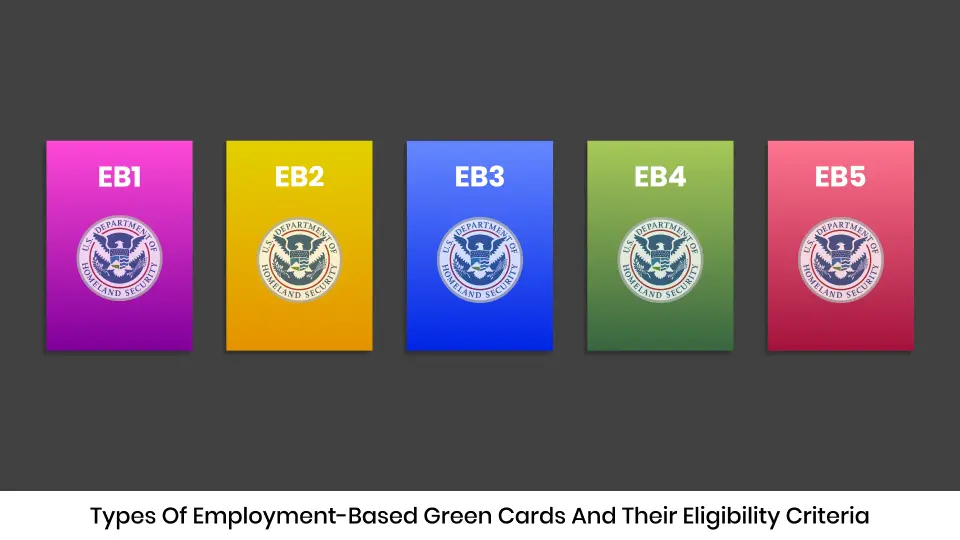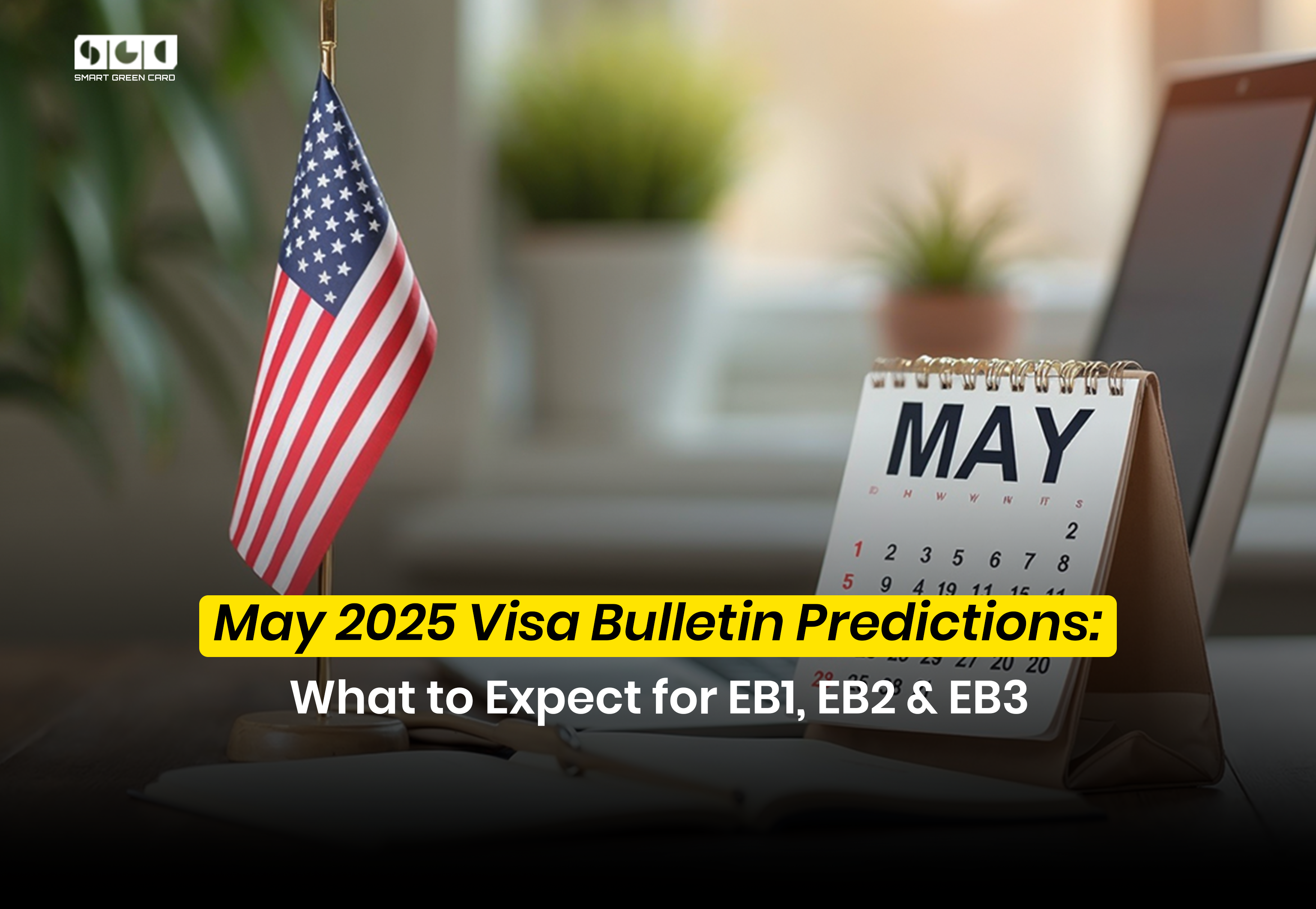Employment-Based Green Cards: Find Your Perfect Path to U.S. Residency

Are you seeking a US green card through employment? Do you want to know the fastest path to US permanent residency for Indians and the types of employment-based green cards available? If so, this blog is for you.
In this blog, we cover the eligibility criteria, process, and benefits of employment-based green cards. Let’s begin.
What Is an Employment-Based Green Card?
Employment-based green cards, also referred to as employment-based immigrant visas, enable foreign nationals to live and work in the US indefinitely, based on their job skills and employment.
These green cards are classified into five categories, each with its own specific requirements.
Types of Employment-Based Green Cards and Their Eligibility Criteria

There are five types of employment-based green cards: EB1, EB2, EB3, EB4, and EB5. Let’s explore the eligibility criteria for the green cards through employment:
EB1 Green Card Categories
EB1 is the employment-based first preference category reserved for extraordinary individuals, outstanding researchers or professors, and certain multinational executives or managers. It is divided into three categories: EB1A, EB1B, and EB1C.
EB1A:
To qualify for EB1A, you must meet three out of ten EB1A criteria. Additionally, your evidence as a whole must demonstrate sustained national or international acclaim. EB1A allows you to self-sponsor a green card and does not require a labor certification or job offer.
EB1B:
EB1B requires showcasing international recognition of outstanding achievements in an academic field. You must also have a minimum of three years of work experience as a researcher or professor in your academic area, along with a job offer from a US university, higher educational institution, or private employer.
EB1C:
To be eligible for the EB1C green card, you need to have worked in a managerial or executive role outside the US for at least one year within the past three years before applying.
Additionally, the foreign company where you are currently employed in an executive or managerial position within the US must have a qualifying relationship with your previous employer abroad.
EB2 Green Card Categories
The EB2 is a type of employment-based green card category that is divided into two types: EB2 and EB2-NIW. Each type has distinct eligibility requirements and benefits.
EB2:
To qualify for EB2, you must either possess an advanced degree or a bachelor’s degree with at least five years of work experience in the field.
Alternatively, you can qualify for EB2 by demonstrating exceptional ability in the fields of arts, sciences, or business, meeting three EB2 criteria.
Additionally, an EB2 green card requires sponsorship by an employer and involves obtaining a labor certification.
EB2-NIW:
EB2-NIW is a self-petition green card, which means you can file your green card application independently with USCIS when you meet its requirements. It doesn’t require sponsorship from an employer or a job offer.
To qualify for EB2-NIW, you need to meet the EB2 requirements and pass the three-prong test:
- Prove that your proposed endeavor is of substantial merit and national importance.
- Demonstrate that you are well-positioned to advance that proposed endeavor.
- Shows that, overall, it would be beneficial for the US to waive the job offer and labor certification requirement.
EB3 Green Card Categories
The EB3 category is an employment-based green card category designed for skilled workers, professionals, and unskilled workers (other workers), providing permanent residency to reside and work in the US.
To qualify for an EB3 green card, applicants must have a full-time job offer from a US employer and obtain labor certification.
- EB3(A) Skilled Worker: Requires two years of job experience or training.
- EB3(B) Professionals: Requires a US bachelor’s degree or foreign equivalent that is required for the job.
- EB3(C) Other Workers: For individuals performing unskilled labor with less than two years of training or experience.
EB4 green card: Special Immigrants
The EB-4 green card is for special immigrants, including broadcasters, religious workers, certain physicians, armed forces members, and international organization employees. Each group has specific eligibility requirements to meet in order to obtain the EB-4 employment-based green card.
EB5 Green Card: Investors

The EB-5 green card, also known as an investor visa, provides a pathway to permanent residency for foreign investors. To qualify, you must invest in a U.S. commercial enterprise. The minimum investment is $1.05 million in most areas, but it is reduced to $800,000 in targeted employment areas (TEAs).
In addition to the investment, you must demonstrate your intent to create or preserve at least 10 full-time jobs for U.S. workers.
The EB-5 program issues a conditional green card initially. Within 90 days before the second anniversary of receiving your conditional green card, you must file Form I-829. This form provides evidence that you have met the job creation requirements. Upon approval, the conditions on your green card are removed, granting you permanent resident status.
Fastest path to US permanent residency for Indians
According to US immigration law, approximately 140,000 green cards are issued annually, which includes dependents of principal green card applicants.
There is also a cap limit on green card issuance at 7% based on the country of origin. Therefore, highly populated countries like India and China are currently facing significant backlogs in the employment-based green card categories.
Typically, high-skilled immigrants pursue the EB1, EB2, and EB3 green card categories. However, for India, the EB2 and EB3 categories have extensive backlogs spanning several decades.
Therefore, the quickest path to permanent residency for Indians may be through the EB1. Within EB1, EB1A offers faster processing as it requires no labor certification. EB1A is also a self-sponsored green card category that does not require a job offer. Final action dates for EB1 or EB1A for India progress rapidly in the monthly visa bulletins.
Green Cards for Family Members

If you qualify for any employment-based green card category, your spouse and unmarried children under the age of 21 are eligible to receive US green cards as derivative applicants.
Conclusion
Individuals holding non-immigrant visas like H-1B, O-1, L-1, etc., often seek permanent residency through the EB-1, EB-2, or EB-3 green card categories. This employment-based green card process involves:
- PERM Labor Certification (for EB-2 and EB-3 only): The employer must first file a PERM application with the Department of Labor (DOL). This proves that they offered a fair wage and advertised the position to U.S. workers before hiring you.
- I-140 Immigrant Petition: This petition establishes your eligibility for the specific EB category you are applying under (EB-1, EB-2, or EB-3). It requires documentation proving you meet the qualifications.
- I-485 Adjustment of Status: Once your priority date becomes current, you can apply to U.S. Citizenship and Immigration Services (USCIS) to adjust your status from temporary worker to permanent resident.
Among the EB-1 categories, EB-1A offers distinct advantages. It doesn’t require employer sponsorship, labor certification, or an advanced degree. You can file your EB-1A petition independently with USCIS.
\Willing to prepare for EB-1A, but not sure how to start? Discover the Smart Green Card VIP plan for guidance and assistance in gathering robust evidence for your EB-1A application.
Share this :
- SGC
- No Comments
Latest blog & Newsletters
May 2025 Visa Bulletin Predictions: What to Expect for EB1, EB2 & EB3
May 2025 Visa Bulletin Predictions: What to Expect for EB1, EB2 & EB3...
Smart Green Card: Expert Guidance for Your U.S. Visa & Green Card Journey
Smart Green Card: Expert Guidance for Your U.S. Visa & Green Card Journey...
H1B Lottery Results 2025: Everything You Need to Know
H1B Lottery Results 2025: Everything You Need to Know The H1B visa lottery...





